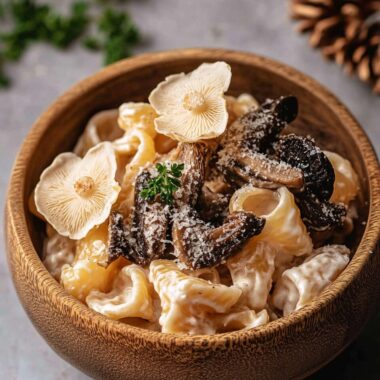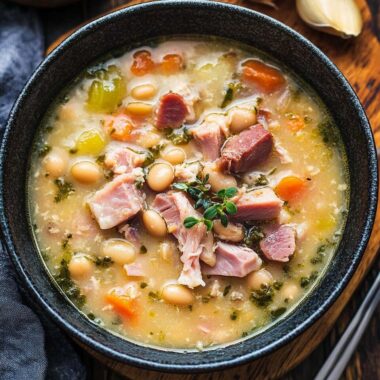The charm of Italian Easter Cookies, or Taralli Dolci, lies in their simplicity and nostalgic flavors. These soft, lemon-scented twists are finished with a delicate vanilla glaze and festive sprinkles perfect for celebrating the season. Often passed down from grandmothers to grandchildren, this recipe brings timeless tradition into the modern kitchen. Whether enjoyed alongside your morning coffee or shared during your Easter brunch, these cookies are as much a joy to bake as they are to eat. With easy-to-find ingredients and a straightforward method, they’re perfect for beginner bakers and seasoned pros alike. Add a personal touch with your favorite sprinkle colors to match your celebration style.
Full Recipe:
Ingredients:
-
3 cups all-purpose flour
-
1 tablespoon baking powder
-
1/2 teaspoon salt
-
4 large eggs
-
3/4 cup granulated sugar
-
1/2 cup vegetable oil
-
1 tablespoon pure vanilla extract
-
Zest of 1 lemon
-
2 tablespoons lemon juice
For the glaze:
-
2 cups powdered sugar
-
2-3 tablespoons milk
-
1 teaspoon vanilla extract
-
Optional: Sprinkles for decoration
Directions:
-
Preheat your oven to 350°F (175°C). Line two baking sheets with parchment paper.
-
In a medium bowl, whisk together the flour, baking powder, and salt.
-
In a large bowl, beat the eggs and granulated sugar until light and fluffy (about 2-3 minutes).
-
Add the vegetable oil, vanilla extract, lemon zest, and lemon juice. Mix until combined.
-
Gradually add the dry ingredients into the wet ingredients, stirring just until the dough forms. It should be soft but not sticky.
-
Scoop out tablespoons of dough and roll into 4-inch ropes. Twist into a loop or knot shape and place on the prepared baking sheets.
-
Bake for 12-15 minutes, or until just lightly golden on the bottom. Cool completely on wire racks.
-
In a small bowl, whisk together the powdered sugar, milk, and vanilla until smooth.
-
Dip the tops of the cooled cookies into the glaze and place back on the rack. Add sprinkles while the glaze is still wet.
-
Allow the glaze to set before serving or storing in an airtight container.
Prep Time: 20 minutes | Cooking Time: 15 minutes | Total Time: 35 minutes
Kcal: 160 kcal | Servings: 30 cookies
Celebrating Tradition with Italian Easter Cookies – Taralli Dolci
Italian cuisine is known and loved across the globe for its deep roots in tradition, family, and celebration. Each region, town, and even family has its own cherished recipes that are often passed down through generations. One such beloved treat, especially popular during the Easter season, is Taralli Dolci, or Italian Easter Cookies. These sweet, ring-shaped or twisted cookies symbolize celebration, rebirth, and the joy of gathering with loved ones.
Their soft crumb, subtle lemony zing, and delicate vanilla glaze make them an irresistible addition to any springtime dessert table. But beyond their delicious taste, Taralli Dolci carry with them a rich cultural story that ties together family, faith, and festivity.
The Cultural Significance of Taralli Dolci
Taralli Dolci have deep roots in Italian heritage. Traditionally made in the days leading up to Easter Sunday, they are a symbol of celebration and new beginnings. The cookie’s ring or knot shape is often interpreted as a representation of unity, eternity, or the cyclical nature of life all themes that resonate with the Easter holiday.
While they are enjoyed year-round in many Italian homes, it’s during religious holidays like Easter and Christmas that these cookies take center stage. Families come together in the kitchen to roll, shape, bake, and decorate batches of these sweets, often using the same handwritten recipes passed down from grandmothers and great-grandmothers.
In many Italian-American households, these cookies are as much a part of the holiday tradition as decorating eggs or attending Sunday mass. They’re often included in festive cookie platters, exchanged as gifts, or served at large family gatherings.
Regional Variations and Family Twists
One of the most fascinating aspects of Italian cuisine is how much it varies by region and Taralli Dolci are no exception. In some regions, like Puglia or Campania, the cookies might be flavored with anise or coated in a sugar glaze. In others, citrus zest like lemon or orange is added for a bright and aromatic finish. Some families include almond extract, while others might drizzle chocolate or dust them with powdered sugar.
The basic concept remains the same a soft, sweet, circular or twisted cookie but the flavor nuances and presentation are beautifully diverse. This regional diversity allows bakers to personalize the recipe to their own tastes or cultural influences while still preserving its traditional essence.
The Symbolism Behind the Shape and Color
Taralli Dolci are typically shaped into loops or figure-eight twists, which aren’t just visually appealing but also rich with symbolism. The rounded form suggests continuity, wholeness, and the eternal nature of love and faith fitting for Easter, which celebrates resurrection and renewal.
After baking, the cookies are usually dipped in a simple glaze made of powdered sugar and milk, sometimes infused with vanilla or citrus essence. The white glaze signifies purity and celebration. Colorful sprinkles, often in pastels, are added on top while the glaze is still wet, offering a vibrant, festive look that makes these cookies especially eye-catching on Easter tables.
A Cookie for All Generations
What makes Italian Easter Cookies so special is their ability to connect generations. In many Italian and Italian-American families, baking Taralli Dolci is an event that spans multiple generations grandparents teaching grandchildren how to roll the dough, form the loops, and dip each one in the glaze with care.
It’s more than just a baking project; it’s a time of bonding, storytelling, and passing on cultural heritage. As younger generations learn the recipe and techniques, they also hear family stories, understand the importance of tradition, and become a part of something timeless.
Tips for Perfecting Taralli Dolci
Though Taralli Dolci are relatively simple to make, a few tips can help ensure the best possible result:
-
Don’t overmix the dough: This ensures the cookies stay soft and tender.
-
Use fresh citrus zest: Fresh lemon zest gives the cookies a vibrant flavor that elevates the entire batch.
-
Shape with care: Whether forming knots or circles, try to keep the shapes uniform in size so they bake evenly.
-
Cool before glazing: Let the cookies cool completely before dipping them in glaze to avoid melting and ensure an even coating.
-
Add sprinkles while the glaze is wet: This ensures they stick and gives the cookies their iconic festive finish.
With these small tips, you can create cookies that not only taste amazing but also look picture-perfect.
A Delight for Modern Celebrations
While these cookies are steeped in tradition, they’re also incredibly versatile and can be adapted for today’s diverse palates and dietary needs. For instance, the recipe can easily be adjusted to be dairy-free or nut-free. Some bakers swap white flour for whole wheat or gluten-free alternatives to accommodate guests with dietary restrictions.
They also make a wonderful addition to cookie exchanges, springtime brunches, or as edible gifts. Wrapped in clear bags with a ribbon, they’re both heartfelt and homemade a gesture that never goes out of style.
Pairing Suggestions
These cookies are perfect when paired with coffee, espresso, or tea. Their mild sweetness and soft texture balance well with a strong cup of Italian espresso or even a light herbal tea.
For dessert platters, they sit beautifully beside other classic Italian sweets like cannoli, biscotti, or ricotta pie. Their colorful glaze and sprinkles make them stand out as a cheerful, eye-catching treat.
Why We Keep Baking Taralli Dolci
In a world where dessert options are endless and often elaborate, there’s something comforting and grounding about returning to recipes like Taralli Dolci. They are a delicious reminder of the joys of simplicity flour, eggs, sugar, love, and tradition.
What keeps us coming back to this cookie is more than just its soft texture or sweet glaze. It’s the memories of baking with family, the laughter in the kitchen, the aroma of lemon and vanilla filling the house. It’s the joy of passing the plate around the table, of children choosing their favorite sprinkle pattern, and of honoring the past while making new memories.
Conclusion:
Italian Easter Cookies, or Taralli Dolci, are far more than a seasonal dessert. They are a symbol of celebration, connection, and continuity. With each twist of dough and each sprinkle-topped glaze, families relive cherished memories and create new ones. These cookies are a reminder that the heart of Italian cooking lies not just in the ingredients, but in the love, intention, and community behind every dish.
Whether you’re an Italian-American rekindling family traditions or someone discovering this recipe for the first time, baking Taralli Dolci is a joyful, meaningful experience. They bring a sense of celebration to any table and invite you to savor the beauty of tradition one bite at a time.








